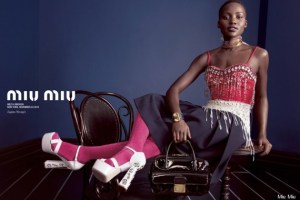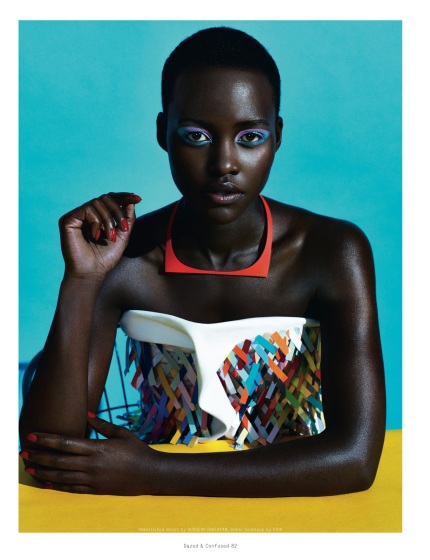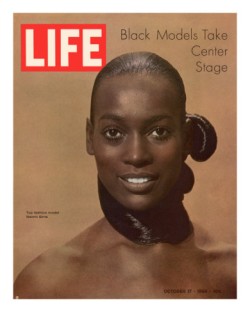She was made of black mother-of-pearl,
made of dark-purple grapes,
and she lashed my blood
with her tail of fire…~Pablo Neruda, The Fickle One
 #beautyheals, to regram an elegant and wise Rebecca Walker hashtag, and nowhere is this more evident than in the current obsession Black women are having with the startling and luminous images of our girl, Lupita Nyong’o, that have flooded the representational sphere this awards season. With everything from a campaign for high-end fashion house Miu Miu underway and an uncounted number of fashion spread features and entertainment industry shout-outs, to the onslaught of love letters and crazed social media fandom, Nyong’o’s sudden, fervent ubiquity points to the fact that we are not the only ones thirsting for a gorgeous, earth-black, African descended beauty revolution. She sits, center stage, poised to interrupt the global pageantry of the Hollywood film industry. As far as we’re concerned, there are no other contenders. In the beauty and talent game, she has won everything except, as poet and scholar Tony Medina reminded us in a recent Facebook post, the Super Bowl.
#beautyheals, to regram an elegant and wise Rebecca Walker hashtag, and nowhere is this more evident than in the current obsession Black women are having with the startling and luminous images of our girl, Lupita Nyong’o, that have flooded the representational sphere this awards season. With everything from a campaign for high-end fashion house Miu Miu underway and an uncounted number of fashion spread features and entertainment industry shout-outs, to the onslaught of love letters and crazed social media fandom, Nyong’o’s sudden, fervent ubiquity points to the fact that we are not the only ones thirsting for a gorgeous, earth-black, African descended beauty revolution. She sits, center stage, poised to interrupt the global pageantry of the Hollywood film industry. As far as we’re concerned, there are no other contenders. In the beauty and talent game, she has won everything except, as poet and scholar Tony Medina reminded us in a recent Facebook post, the Super Bowl.
It is an American racial paradox that Lupita’s rise to beauty stardom was on the back of the character “Patsy”, the brutally raped and generally downtrodden bondage woman in  Steve McQueen’s film, 12 Years A Slave. But her Oscar-worthy portrayal of wretchedness in that spectacular role was a small price to pay for catapulting her into the pale-skinned, hair-weaved, anaretic Western beauty consciousness. In the case of Lupita’s casting, McQueen’s use of the conventions of the “neo-slave narrative” – whose role is to fill-in the oft-excluded emotional ravages of slavery to appeal to the sensibilities of northern white abolitionists – served to demonstrate the pain that white ideas of beauty have always inflicted on Black women. This portrayal is a reminder of how the systemic dehumanization of Black women was implemented, and helps us to imagine the origins of the story of our “ugliness.”
Steve McQueen’s film, 12 Years A Slave. But her Oscar-worthy portrayal of wretchedness in that spectacular role was a small price to pay for catapulting her into the pale-skinned, hair-weaved, anaretic Western beauty consciousness. In the case of Lupita’s casting, McQueen’s use of the conventions of the “neo-slave narrative” – whose role is to fill-in the oft-excluded emotional ravages of slavery to appeal to the sensibilities of northern white abolitionists – served to demonstrate the pain that white ideas of beauty have always inflicted on Black women. This portrayal is a reminder of how the systemic dehumanization of Black women was implemented, and helps us to imagine the origins of the story of our “ugliness.”
Over the years, we’ve had our cultural obsessions with dark-skinned African descended men (Sidney Poitier, Wesley Snipes, Djimon Hounsou and Idris Elba come to mind). This is to be expected within a culture in which Black male sexuality is both fetishized and feared and dark skin speaks to both desire and deathwish. Notwithstanding, Black women in the representational sphere have, almost exclusively, been considered desirable only when we are portrayed as half-white or otherwise obviously mixed-race versions of ourselves (Halle Berry, Paula Patton, Zoe Saldana, Thandie Newton and Rashida Jones, to cite modern examples). Which isn’t to say that mixed-race or lighter skinned Black women aren’t beautiful and worthy of admiration. Not at all. It is to say that the oversaturation of light-skinned images of Black women – a product of racial ideologies that structure ideal beauty along a hierarchy that positions white skin at the top and dark skin at the bottom – has contributed to the devastating erasure in the conceptual realm of romance, beauty and love consciousness in the West. We suspect that this conceptual erasure is behind the lack of desire or interest in Black women on dating sites, the abysmal percentages of Black women being “chosen” for marriage, the way that mainstream corporate hip-hop is allowed to depict us and, once again, the devastating rates (60%, yall!) of sexual assault and abuse visited on Black girls before age 18.
We believe that representational trauma has a real impact on the psyches and self-esteem of Black women and girls, and in the last decade, it seems that every intervention we’ve seen in the realm of empowering Black female beauty has been countered by its opposite. Consider:
-
Oprah putting her face on the cover of her own magazine every month has been countered by Essence Magazine being bought out by Time Inc. who now, all but refuses to feature Black women with natural hair on its cover;
-
A biopic of our beloved Nina Simone is misrepresented by the casting of Zoe Saldana in the title role;
-
The hype around the film adaptation of Chimamanda Ngozi Adichie’s award winning novel Half of a Yellow Sun insults us with the casting of Thandie Newton as the thick-bodied, brown-skinned protagonist;
-
Kerry Washington’s spectacular African features in Neutrogena ads are undermined by a blonde-weaved, photoshop-lightened Beyonce emphasizing her “mixed-race” skin for a L’oreal campaign;
-
Carol’s Daughter, catapulted into the stratosphere by black- and brown-skinned girls from Brooklyn to Seattle, publically declaring that only light-skinned, mixed-race women were appropriate spokespersons for their brand; and
-
Michelle Obama’s regal beauty challenged by powerful white male political commentators who are allowed to ridicule her weight, her height and the size of her backside as if she were on an auction block and with hardly any backlash.
Even now, on the cusp of an archetypal transformation for Black women in popular media, Vanity Fair, that bastion of all things Hollywood glamour, still doesn’t get it. In a recent photo shoot featuring Nyong’o, the magazine countered what appears to be this moment’s universal admiration for dark skinned beauty by portraying her as several shades lighter than her actual skin tone.
In misogynist patriarchies, hierarchies of female desirability are established to maintain the status quo. For decades, researchers have presented compelling analyses that support this so let’s not pretend that the racial pecking order ain’t real. Even scholar and MSNBC talk show host Melissa Harris Perry revealed the ways that she, as a light-skinned, mixed-race Black woman, has been seduced by the power of colorism:
“Because I’m light-skinned, and cis, and straight, and have a white parent, and have access to all kinds of privileges from birth, my bet is that I have been seduced by power….my bet is that my proximity to whiteness has allowed me over and over again a level of racial naiveté and a willingness to believe that if I could just get the right white folks to give me cover, that it will be OK.”
Remember the Alicia Keys/India Arie debates of 2002 around their grammy nominations and how mainstream media manufactured a feud between the women based on the presumed privileging of Keys as a light skinned, mixed race Black woman? Or Ariegate 2013 – the scandal over Arie’s lighter skin hue on the album cover for her single “Cocoa Butter?” Black women are reminded of our place in the hierarchy when we see our favorite Black girl actresses, models, musicians and pop culture icons transformed from dark haired, round bodied realness to blonde, airbrushed, skin bleached cyborgs that maintain tired representational ideals of ‘light is right’ and ‘black get back’.
This issue of colorism for Black women has had some devastating impacts, particularly in terms of our relationships to one another, and we can’t let our fear of disrupting Black girl solidarity prevent us from talking about the reality of colorism and its effects. Here are some recent social facts to consider:
-
Researchers at Villanova University compared skin color and sentencing patterns of over 12,000 African American women in North Carolina prisons and found that light skinned Black women received shorter sentences than dark skinned Black women;
-
A 2006 study published by the Association of Psychological Science found that the more “stereotypically Black” a defendant is perceived to be (and dark skin color was one of these characteristics), the more likely that person was sentenced to death;
-
Economists have found that light skin yields a 15% greater probability of marriage for young Black women and the presence of more educated and higher-earning spouses for married Black women; and
-
Kiri Davis’ powerful documentary A Girl Like Me presents young Black girls’ stories of colorism and recreates the classic “doll test” created by psychologists Kenneth Clark and Mamie Phipps Clark showing how, even among the post-segregation, post-girl empowerment generation, young Black children still privilege whiteness over Blackness.
One way to heal the fissures created by a global white supremacist beauty mandate is, of course, to increase portrayals of gorgeous, dark-skinned Black women in the representational sphere. We have to come up with creative strategies to heal our trauma around beauty and to create new versions of ourselves to celebrate and love. In the same way that Sweden has, for example, implemented a new rating system that considers the portrayal of women or that writer Inga Muscio documents the prevalence of rape culture in film, we must figure out ways to ensure that we aren’t triggered by images of us as abysmal creatures from the white imaginary.
For us, Lupita is a veritable coup in the psyche of the American propaganda machine. As part of a legacy of ‘Black is beautiful’ imagery evoked by the likes of Cicely Tyson, Nina Simone, Naomi Sims, Grace Jones, Alek Wek and Lauryn Hill, she is in the tradition of Black transgressive resistance to the limitations of dominant cultural representations. Our hope is that her image not only generates new conceptual options of beauty for our 21st century Black girls, but that she ignites, in the spirit of the late cultural critic Richard Iton, a black fantastic that strikes at the core of a system that excludes dark-skinned black women for the preservation of a racist, sexist and heteronormative status quo.
Photo Credits: Visual Optimism; HuffPost Black Voices; CraveOnline; Arta Chic


Wonderful piece! Thank you from a 61 yr. old black feminist and retired art historian at the light end of the color spectrum. It outrages and saddens me that we still NEED to discuss these issues after Nina Simone, Naomi Sims, Lauren Hill, Alek Wek, et al. But since we obviously DO, I’m thrilled to see you doing it so well. Thanks for bringing me up to date on anti-black woman ugliness of which I was unaware such as the insults about Michelle Obama’s looks. (I only knew about the snipes about her biceps–an obvious racial diss to anyone familiar with the frequency of long, slim limbs among descendants of Sudanic, as opposed to Bantu, African types).
One question: I had to look up the term “cis.” (I’m old enough to have trouble remembering the nuances of words that are relatively new to me…) Was surprised to see there doesn’t seem to be a term for people who consider themselves “cis” but are often viewed differently by others. As a tall, lean female I’ve been greeted as “Sir,” pointed at by a tourist guide as an example of transvestism and regarded with alarm in women’s restrooms. Though I sometimes suspect there is a racial component to the gender confusion, I know tall, supposedly “unfeminine”-looking white women who have this problem too. It’s particularly tricky because of the pervasive assumption that appearance tracks with sexual preference. Is there terminology or a discourse that addresses these issues?
Wonderful piece! Thank you, from a 61 yr. old black feminist (Ms. Magazine associate editor 1975-77) and retired professor of African American art history and race representation.
Thanks so much for this post. May the beautiful, talented, whip-smart Lupita have a long and fruitful career.
Reblogged this on Don't Sleep on Old Eggs and commented:
For all my Brown Skin Ladies out there. Love this post from Real Colored Girls!
“You fruitful, beautiful, smart, lovable, huggable
Doable like art, suitable to be part
Of my life, Coppertone, oh, you copyright infringement
Pay you bidness ten cents, way back in the day
It’s like I’m standin’ there you know appreciatin’ God’s design
And then you showed up, it’s like you read my mind…”
Brown Skin Lady, Black Star (Dante Smith/Mos Def/Yasiin Bey and Talib Greene/Talib Kweli)
[…] could change the beauty game and the reception of black female bodies. At least she provides healing for some and excitement for others. But in an atmosphere that can recast pop artists like Beyoncé as […]
If our adversaries are successful they will win without even fighting which tells me that their strategy comes directly from the Art of War.
The highest and best strategy in the Art of war is to win without fighting and that’s how come I know that we are at war.
The strategy of win without fighting depends on winning over the hearts and minds of the people and if they are successful they will kill 3 birds with one stone.
1. Financially the slave movie empties our pockets, submits our minds and surrenders our will to resist the re-indoctrination to chattel slavery.
2. The slave movies indoctrinate the hearts and minds of “we the people” to see black people as nothing but slaves thereby blinding them from seeing any outside evidence validating us as human beings.
3. Our slavery is viewed accepted and approved by us in the hearts and minds of the world because our adversaries can prove that with free will we paid good money to watch and act in slave movies and that we also openly fought with each other if anyone of us disagreed to go along.
Our adversaries strategy comes directly from the book, “The Art of War” and……… ….we are at war.
Another great article! Please post more often 🙂
I love to disseminate knowledge that will I have accumulated with the yr to help improve group
functionality.
hello!,I really like your writing very a lot! proportion we communicate
extra approximately your post on AOL? I need a specialist in this house to resolve
my problem. May be that’s you! Taking a look forward to peer
you.